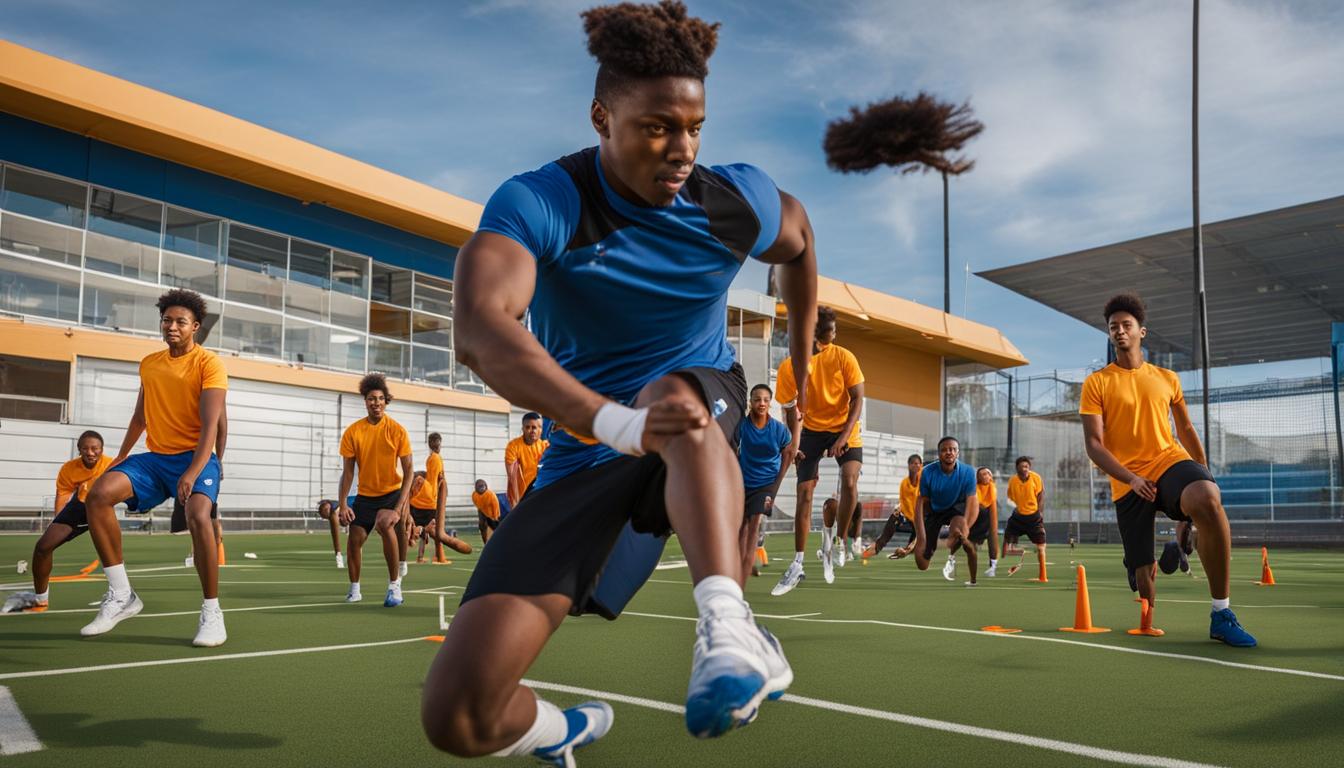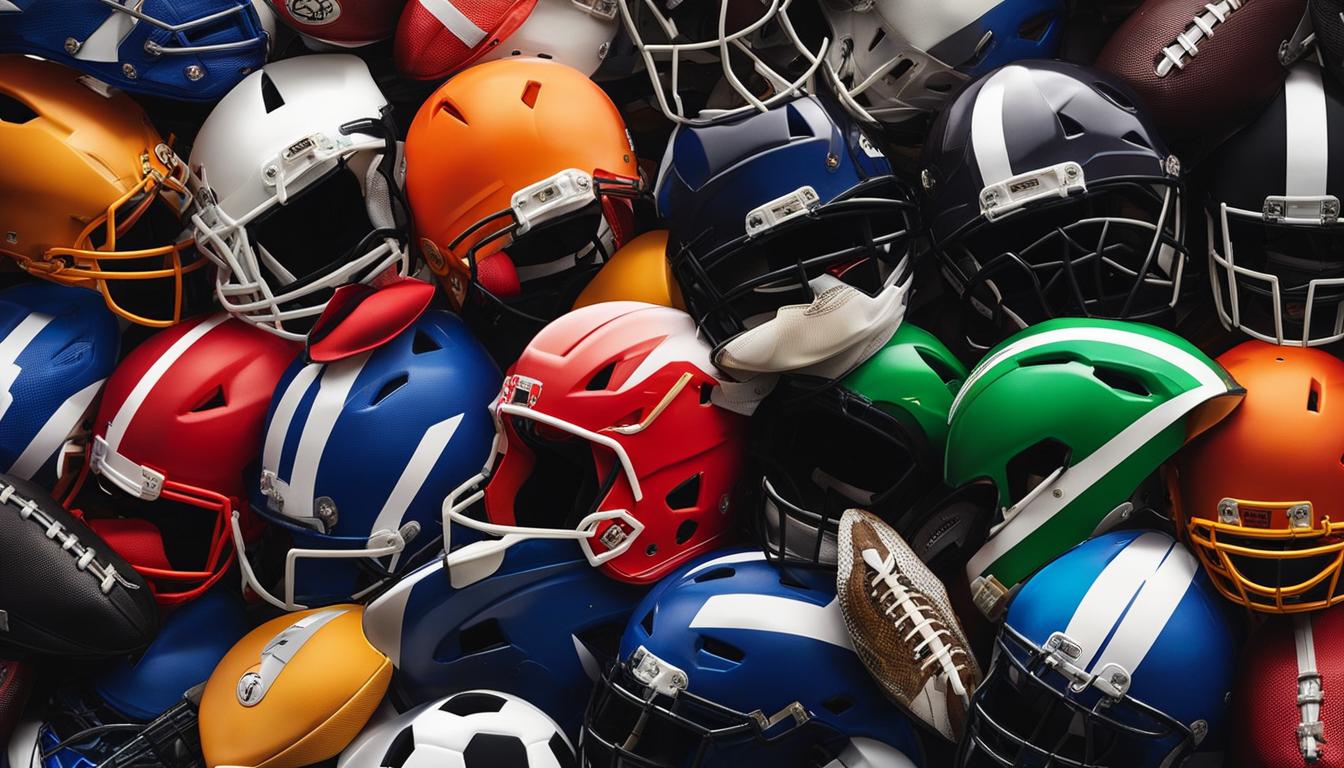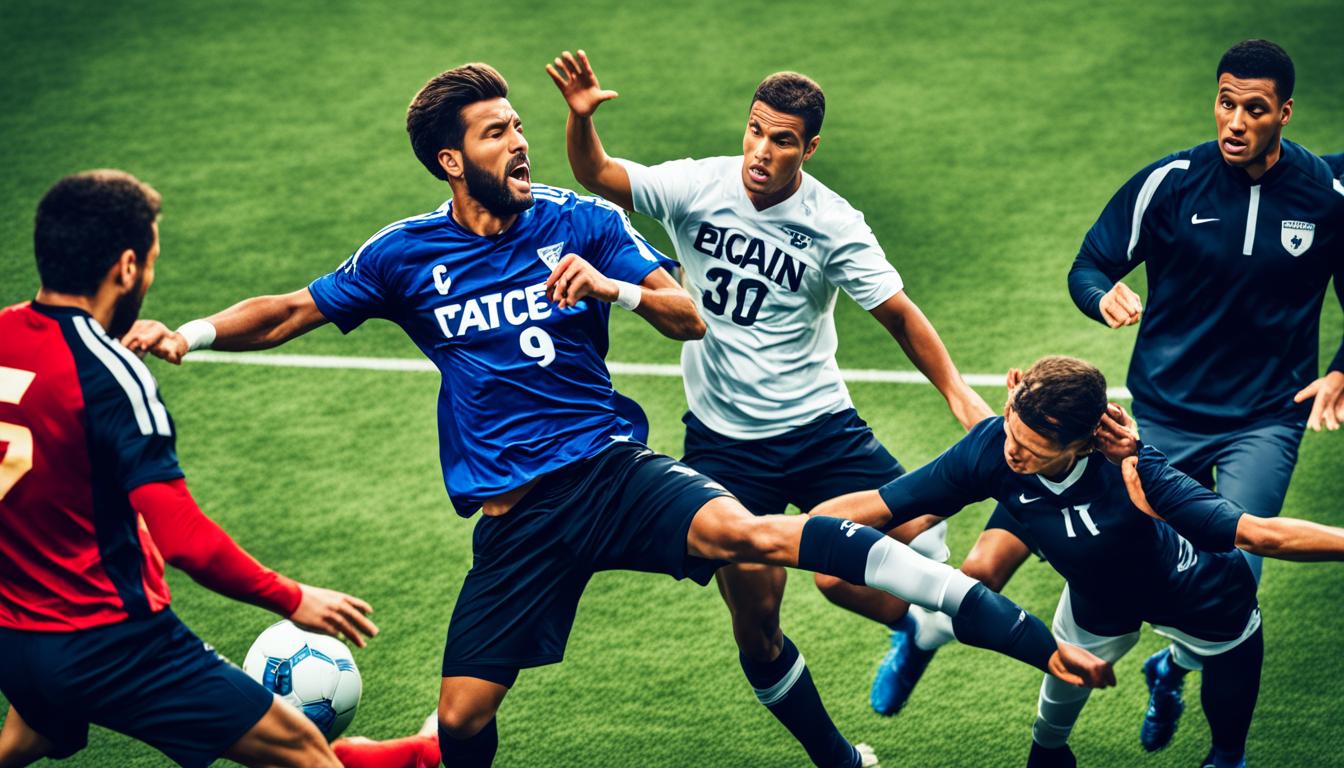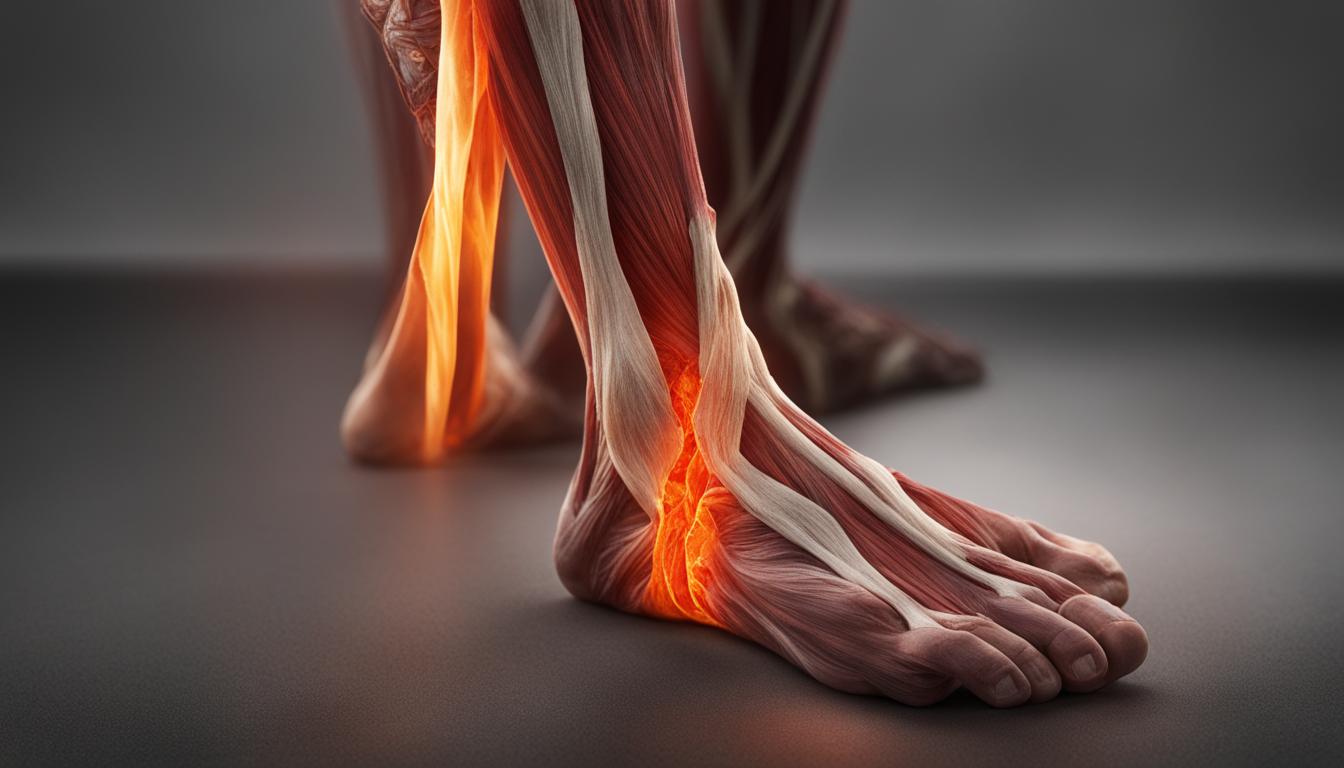Participation in sports offers social, emotional, and physical benefits for children. However, it’s important to prioritize safety and take steps to prevent injuries. By following these sports injury prevention tips and strategies, you can help ensure that young athletes stay safe and healthy on the field.
Key Takeaways:
- Engaging in sports provides numerous benefits, but safety should always be a top priority.
- Take preventive measures such as receiving a pre-participation physical exam and wearing appropriate sports gear.
- Warm up and stretch before every practice and game to reduce the risk of muscle strains and other injuries.
- Stay hydrated by drinking water before, during, and after play, and be aware of the signs of dehydration and heat illness.
- Recognize the signs and symptoms of concussions and ensure immediate removal from play for evaluation by a medical professional.
Prepare Kids for the Demands of Playing a Sport
Before your child participates in organized sports, it is crucial to prioritize their safety and well-being. One essential step in this process is to ensure that they undergo a pre-participation physical exam (PPE). This exam is designed to identify any underlying health issues that could potentially put your child at risk during physical activity.
The pre-participation physical exam should be performed by a qualified healthcare professional, such as a doctor, nurse practitioner, or clinician supervised by a physician. It is essential to provide accurate medical history during the exam, as this information can help the healthcare professional assess your child’s suitability for certain sports and identify any specific precautions or interventions that may be necessary.
As a parent, it is important to inform your child’s coaches of any medical conditions your child may have, such as asthma or allergies, that require special attention during sports activities. This ensures that the coaches are aware of any potential risks and can take appropriate measures to keep your child safe.
In addition to the pre-participation physical exam, it is crucial for coaches to have access to emergency contact information for each child. This information should be readily available and easily accessible in case of any medical emergencies that may arise during practices or games.
By prioritizing the pre-participation physical exam, accurate medical history, and emergency contact information, you are taking important steps to ensure that your child is prepared and equipped to handle the demands of playing a sport safely.
Warm Up and Stretch Before Games and Practices
Before diving into intense physical activity, it’s important to give your body the warm-up it deserves. Coaches should set aside time before every practice and game for athletes to properly warm up. This not only prepares the body for the demands of sports but also helps prevent injuries that could sideline you from play.
Start your warm-up with some light aerobic activity, like jogging or brisk walking, for about 10 minutes. This gets your heart pumping and increases blood flow to your muscles, priming them for action. Then, it’s time to focus on stretching.
Stretching all major muscle groups is key to maintaining flexibility and reducing the risk of muscle strains or tears during the game. You can perform stretches for your calves, hamstrings, quadriceps, hip flexors, shoulders, and more. Remember, each stretch should be gentle and held for about 10-30 seconds, without bouncing or causing pain.
Proper warm-up exercises not only physically prepare your body but also help release muscle tension, improve coordination, and enhance overall performance. So, make it a habit to warm up and stretch before every practice and game to give your body the best chance of staying injury-free.

Remember to Hydrate
Proper hydration is essential to keep your body functioning at its best during physical activity. Dehydration can lead to serious health issues and compromise your performance on the field. By understanding the signs and symptoms of dehydration and prioritizing fluid intake, you can stay hydrated and prevent potential complications.

Dehydration occurs when your body loses more fluid than it takes in. Common signs of dehydration include feeling thirsty, dry mouth, dark urine, fatigue, and dizziness. Ignoring these signs can lead to heat illness, which can be life-threatening.
To avoid dehydration, it’s important to have a water bottle with you during practice and games. Make sure to drink plenty of water before, during, and after physical activity. Aim to consume fluids 30 minutes before starting and take water breaks every 15-20 minutes during the activity.
Coaches play a crucial role in ensuring athletes stay hydrated. Establishing mandatory water breaks and educating athletes on the importance of hydration can help prevent dehydration-related issues. Remember, drinking water is essential for peak performance and overall well-being!
Wear Appropriate Sports Gear
Using appropriate and properly-fitted sports gear is vital in preventing and reducing the severity of injuries. When it comes to sports, safety should always be a top priority. Ensuring that athletes have the right equipment for both practices and games can make a significant difference in their overall well-being on the field.
So, what kind of sports gear should athletes be using? Here’s a comprehensive list to keep in mind:
- Helmets: Protect your head with a well-fitting helmet that meets the specific safety requirements for your sport.
- Shin Guards: Keep your legs protected from potential impacts or injuries by wearing shin guards appropriate for your sport.
- Mouth Guards: Safeguard your teeth and jaw by wearing a properly-fitted mouth guard during physical activities.
- Ankle Braces: Provide stability and support to your ankles by wearing braces designed to protect against sprains and strains.
- Shoes with Rubber Cleats: Choose sports-specific shoes that offer proper traction and stability on different playing surfaces.
- Sunscreen: Protect your skin from harmful UV rays by applying sunscreen with adequate SPF before heading out to play.
By investing in high-quality sports gear and ensuring a proper fit, athletes can significantly reduce the risk of injury and enhance their overall performance. Remember, each sport may have its specific equipment requirements, so it’s crucial to do thorough research and consult with experts or coaches to make informed decisions about the gear you need.

Don’t Take Chances with the Brain: Know the Signs and Symptoms of Concussions
When it comes to the brain, it’s crucial never to take chances. Concussions are a common type of sports-related injury that can have serious consequences if not properly addressed. That’s why concussion awareness is so important for coaches, parents, and athletes alike.
If you suspect a concussion, the most important step is to immediately remove the athlete from play. Continuing to participate in activity can worsen the injury and delay recovery. Once removed from play, it is essential to have the athlete evaluated by a medical professional who specializes in concussion management. This ensures proper diagnosis, treatment, and guidance for a safe return to play.
Recognizing the signs and symptoms of concussions is crucial for prompt action. These can include headache, dizziness, confusion, memory problems, nausea, and changes in vision or balance. Emotional and behavioral changes may also be present. It is important to educate yourself and those around you about these signs and symptoms, so you can respond quickly and effectively if a concussion is suspected.
Know the signs, protect your brain! Immediate removal from play is crucial if a concussion is suspected.
When in doubt, it’s always better to err on the side of caution. Sitting out and seeking proper medical evaluation is the best way to ensure the brain’s safety. Remember, a concussion is a brain injury, and it should never be taken lightly. By prioritizing concussion awareness and taking prompt action, we can help protect the long-term well-being of athletes on and off the field.

Make Rest a Priority
Athletes should prioritize rest during practices and games to avoid overuse injuries. Pushing your body beyond its limits without adequate rest can lead to various types of injuries, including overuse injuries. These injuries occur when repetitive stress is placed on a specific part of the body without sufficient time for recovery.
To prevent overuse injuries, it is crucial to listen to your body and take breaks when needed. If you start feeling pain or discomfort during a game or practice, don’t ignore it. Take the necessary steps to communicate your pain, injury, or illness to your coaches, parents, or another responsible adult. Open and honest communication is vital in ensuring that your health and safety are prioritized.
Taking at least one or two days off each week from a particular sport is essential to allow your body to rest and recover. This rest period allows your muscles, joints, and other body tissues to heal and rebuild, reducing the risk of overuse injuries and improving overall performance when you return to the game.
Remember, rest is not a sign of weakness; it is a crucial component of your athletic journey. By giving your body the time it needs to recover, you can avoid overuse injuries and continue enjoying the sports you love for years to come.
Taking breaks and prioritizing rest is essential for athletes to prevent overuse injuries and ensure long-term well-being.
Conclusion
In summary, sports injury prevention is paramount to ensure the safety and well-being of athletes, allowing them to participate in the sports they love without unnecessary risks. By implementing the tips and guidelines for injury prevention, athletes can not only maximize their performance but also reduce the likelihood of sustaining injuries on the field.
Parents and coaches play a crucial role in creating a safe and supportive environment for young athletes. It is essential for them to stay proactive in implementing strategies such as pre-participation physical exams, warm-up exercises, proper hydration, appropriate sports gear, concussion awareness, and prioritizing rest. These measures collectively contribute to the overall safety and longevity of athletes’ sporting careers.
By prioritizing sports injury prevention, athletes can continue to enjoy the physical, social, and emotional benefits that sports offer, while minimizing the risk of preventable injuries. Remember, safety should always be the top priority for athletes, coaches, and parents alike.
FAQ
Why is it important for children to receive a pre-participation physical exam?
The pre-participation physical exam is important to catch any underlying health issues that could increase the risk of injury during sports activities. It helps ensure that children are physically fit and able to participate safely.
What should I do if my child has asthma or another medical condition?
It is important to inform coaches about any medical conditions your child has, such as asthma. This will allow them to provide appropriate care and take necessary precautions to prevent complications during sports activities.
Why is warming up and stretching important?
Warming up and stretching before games and practices can help release muscle tension and improve flexibility, reducing the risk of sports-related injuries.
How can I ensure my child stays hydrated during sports activities?
Make sure your child has a water bottle and encourage them to drink plenty of water before, during, and after play. Establish mandatory water breaks and educate your child about the signs and symptoms of dehydration.
What sports gear should my child wear?
Your child should wear appropriate and properly-fitted sports gear, including helmets, shin guards, mouth guards, ankle braces, shoes with rubber cleats, and sunscreen, to reduce the risk of injuries.
What are the signs and symptoms of a concussion?
It is important to be aware of the signs and symptoms of concussions, such as headache, confusion, dizziness, nausea, and memory problems. If a concussion is suspected, the athlete should be immediately removed from play and evaluated by a medical professional.
Should my child take breaks from playing a particular sport?
Yes, it is important for your child to take at least one or two days off each week from a particular sport to allow their bodies to rest and recover. Rest is crucial in preventing overuse injuries.
Why is sports injury prevention important?
Sports injury prevention is crucial in allowing athletes to continue participating in sports they love without unnecessary risks. By following the tips and guidelines for injury prevention, athletes can maximize their performance and stay safe on the field.
Source Links
- https://www.safekids.org/tip/sports-safety-tips
- https://www.hss.edu/pediatrics-tips-help-teens-train-compete-safely-sports.asp
- https://www.hopkinsmedicine.org/health/wellness-and-prevention/sports-safety


